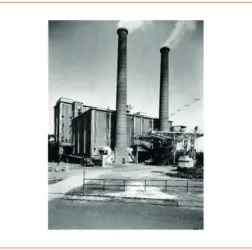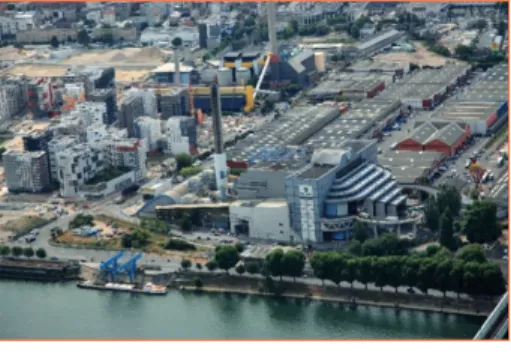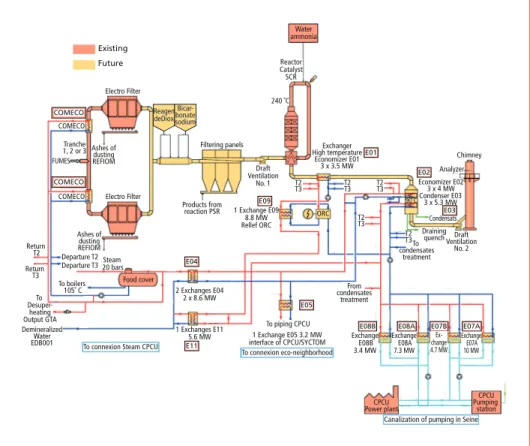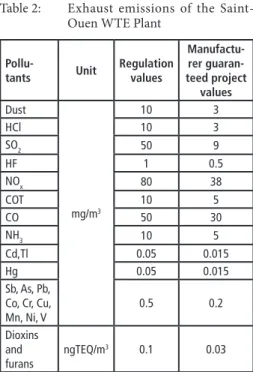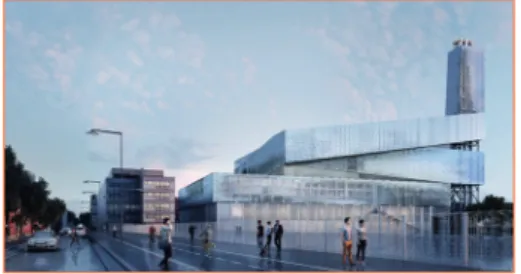Policies/Str
Operation of Three Waste-to-Energy Plants in Paris – Experience of a Major European Municipal Solid Waste Public Authority and Outlook on Strategic Development Projects –
Pierre Hirtzberger and Frédéric Roux
1. Issy-les-Moulineaux: Landscape integration of a new plant
in the heart of the city ...73
1.1. The challenges ...73
1.2. Key characteristics ...74
1.3. Optimisation perspectives ...74
2. Saint-Ouen-sur-Seine WtE plant (France): a waste-to-energy plant project with maximum optimisation of energy from waste ...75
2.1. Timeline of the Saint-Ouen-sur-Seine plant ...75
2.2. Performance levels of the current plant ...76
2.3. The renovation project ...77
2.3.1. Choice of flue gas treatment system ...77
2.3.2. Optimised energy recovery ...77
2.4. Expected energy gain ...79
2.5. Environmental performance of the future flue gas treatment system ....79
3. The Syctom incineration plant conversion project at Ivry-Paris XIII ....80
3.1. The challenges of the project ...80
3.2. The key characteristics of the future facilities ...81
3.3. Phasing to ensure continuity of public service in terms of household waste management...82
3.4. The energy performance of the WTE plant ...82
3.5. The WTE plant: a first-class environmental solution for reducing pollution and disturbances in urban areas ...83
3.6. Upgradability of the facility ...83 Syctom, the Greater Paris public authority for solid waste management, processes 2.3 million tonnes of waste annually, produced by six million residents in the Metro- polis of Greater Paris. As the largest public authority for household waste management in Europe, Syctom processes 10 % of all waste produced by the French population.
Policies/Str
Syctom recovers more than 80 % of the waste it manages in the form of heat, supplied to the urban heating network operated by the Parisian Company for District Heating – Compagnie Parisienne de Chauffage Urbain (CPCU). As such, this energy is used to heat the equivalent of 300,000 homes, including the main hospitals and museums in Paris. The three facilities also produce electricity to cover their own needs. Syctom’s energy strategy is clearly oriented towards heat for the district heating network.
The three waste-to-energy plants owned by Syctom, offering a global treatment capacity of 1.8 million tonnes of household waste, are operated by private service providers with whom Syctom has concluded public operating contracts. The three plants are of three different generations: the oldest and largest, in Ivry-sur-Seine, commissioned in 1969, and is undergoing an ambitious reconstruction programme. The Saint-Ouen facility, launched in 1990, initially based in an industrial zone, is now located in a residential district and is consequently receiving an extensive overhaul to adapt it to the surroun- ding urban transformation. Lastly, the Issy-les-Moulineaux plant, which opened in 2007, is a model of urban and architectural integration, demonstrating that energy recovery is entirely compatible with dense city functioning. Indeed, the Metropolis of Greater Paris territory is characterised by one of the highest levels of density in the world, at 20,000 people per km².
The presence of waste-to-energy plants in dense cities represents an opportunity while also creating significant challenges. Proximity represents a real asset for the efficient organisation of waste collection and facilitates exemplary recovery of thermal energy produced. It requires exemplary design and operation: architectural integration into the city and minimised impact on the environment and residents.
Syctom’s future strategic developments are based around compliance with the Euro- pean circular economy package: increasing the quantity of waste recycled, food waste in particular, and adapting to lower incineration capacities to take account of the expected decline in residual waste amounts to be treated. In parallel, energy optimi- sation measures in the three facilities should make it possible to maintain high levels of energy supply to the district heating network from declining quantities of residual waste: maximum recovery of energy contained in flue gases, the use of steam turbine typologies, and total condensation of flue gases at the Saint-Ouen plant.
Saint-Quen
Issy-les-moulineaux Ivry-Paris XIII
T7
T9 T8 T5 T6
T1
T12 T10 T3 T2
T4
VGP
Paris
Figure 1:
The three waste-to-energy plants in Paris
Policies/Str
1. Issy-les-Moulineaux: Landscape integration of a new plant in the heart of the city
1.1. The challenges
Completion of this project in the town of Issy-les-Moulineaux, very close to the outskirts of Paris, was conditioned by a number of basic requirements, defined by the local mayor and Syctom’s policy representatives: a plant integrated into the city, without visible flue gas emissions, and highly efficient from an environmental and energy perspective.
Syctom, the designer of this plant na- med Isséane, for which studies began in 1999, met this challenge by pursuing exemplarity in the final rendering of the facility. Local urban planning regulations at the time of design limited the height of the buildings to + 21 m. The design of this waste-to-energy plant, with a capacity of 510,000 t/year, thus required underground use for installation of the necessary industrial equipment: two boi- ler furnace units of 85 MWth associated with a flue gas treatment system of dry type using sodium bicarbonate, a condensing steam turbo-generator set equipped with a controlled extraction system in order to supply steam at 20 bars and 230 °C to the CPCU urban heating network.
Located by the edge of the Seine, the project made clever use of this proximity, firstly during the works phase (a temporary flyover connected the site to the river, thereby enabling removal of earthworks and conveyance of the main equipment), then during operation with the removal of clinker directly by barge from the plant via a series of conveyors. After four years of works, including almost two years devoted to structural engineering alone, the facility entered into service at the end of 2007.
The Isséane example has shifted the paradigm, with no olfactory or noise pollution, environmental performance levels well within the thresholds authorised by European regulations, and the objective of continuously improving energy recovery from waste resources.
This acceptability comes at a cost: 600 million EUR ex. VAT for Isséane, including 50 million EUR for the site alone, entirely funded by the public authorities.
Figure 2: Aerial view of the Issy-les-Mouli- neaux W-t-E Plant
Figure 3 : Pedestrian view of the Issy-les- Moulineaux W-t-E Plant
Policies/Str
1.2. Key characteristics
On a site of 38,000 m², this facility required 660,000 m3 of earthworks in order to create the area housing the industrial equipment at a depth of - 31 m. A watertight enclosure (of 1,000 linear m) made from moulded partitions of 1 m in thickness and 50 m in depth surrounds the site in order to protect it from water inflow. Nonetheless, a drainage apron at the base of the plant collects interstitial resurgences (70 m3/h) in order to balance hydrostatic pressure levels.
In total, 220,000 m3 of concrete was required, together with 22,000 tonnes of framework (three times the weight of the Eiffel Tower) in order to create this watertight casing.
Figure 4: Isséane cross-section
Source: Hitachi Zosen Inova
This treatment plant is equipped with two furnaces with a capacity of 30.5 tonnes per hour. A flue gas recirculation system (15 % of total output) makes it possible to obtain a recovery rate of 85 % and to restrict the formation of NOx by reducing the supply of fresh air for secondary air, while automatic regulation of combustion restricts flue gas oxygen content to 6 %. The turbo-generator set simultaneously enables 100 % electrical or cogeneration operation and controlled 20 bar steam extraction.
In 2018, 1 million tons of steam were supplied to the district heating network, and 46 GWh of electricity were exported to the network, through the recovery of 502,000 tonnes of household waste, with an average calorific value of 9,000 kJ/kg.
1.3. Optimisation perspectives
Priority recovery in the form of heat almost all year round renders the turbine origi- nally installed non-optimal in terms of recovery output, since the blowthrough steam output required to cool the final stages of the turbine cannot be recovered for the dis- trict network. This represents approximately 10 % of the input rate, or approximately 20 t/h. In order to increase steam recovery, a back-pressure turbine could be installed in addition to the turbine in place, particularly for the heating period (October to April).
Policies/Str
Furthermore, the energy contained in the fl ue gases at 200 °C on completion of treat- ment could be recovered by means of fl ue gas/water exchangers to heat condensates (produced by the condenser or heat network returns) in order to raise the temperature level before return to the feedwater tank. Th is system would save consumption of steam used to reheat feedwater before boiler injection, in order to maximise, here too, the fl ow of steam delivered to the district heating network.
2. Saint-Ouen-sur-Seine WtE plant (France): a waste-to-energy plant project with maximum optimisation of energy from waste
2.1. Timeline of the Saint-Ouen-sur-Seine plant
Syctom’s incineration plant in Saint Ouen entered into service in 1990, replacing a pre- vious plant dating back to the 1950s. Th is facility processes around 600 kt of household waste annually, produced by 1.6 million residents, and recovers 1.2 million tonnes of steam (20 bar – 230 °C) and 10,000 MWh of electricity. To achieve this, it uses three Stein Industrie furnaces with a capacity of 28 t/h, linked to 65 MWth boilers producing 72 t/h of steam at an eff ective rate of 40 bar and 380 °C, and a 10 MW back-pressure turbine.
In the 1990s, the site was located in an industrial zone on the outskirts of the town of Saint-Ouen-sur-Seine. Over the last 25 years, the development of the Metropolis of Greater Paris has seen the construction of 4,000 homes in this town, including 800 within immediate proximity of the facility.
Figure 5 : Th e plant in Saint-Ouen-sur-Seine in the 1950s
Th e facility’s acceptability thus became a major issue for Syctom, whose principle is always to process collected waste very close to production sites, for two reasons:
• the principle of responsibility, which requires the treatment of waste within the same territory as that of its produc- tion and
• the need for treatment within proxi- mity of the district heating network.
Figure 6: Th e plant in Saint-Ouen-sur-Seine and its surrounding environment in 2000
Policies/Str
In 2012, the decision was taken to modernise this site, in order to make it even more effi cient from an energy and environmental perspective, as well as to integrate it into its new urban environment by means of an ambitious architectural and landscaping project.
Th e original fl ue gas treatment method, of moist two-layer type with catalytic treatment of nitrogen oxides, generates a strong vapour mixture poorly accepted by the new residents, despite its high environmental performance levels, with emissions well below the thresholds au- thorised by European regulations. It also generates a signifi cant quantity of salt- laden liquid effl uents, the evacuation and treatment of which place an increasing burden on transport facility and sewage purifi cation operators. Generally speaking, Syctom has sought to drastically reduce all forms of water usage, taking account of the constant pressure on the river Seine, both in terms of the quantities taken and the quality of discharges with regard to pollution load and temperature.
2.2. Performance levels of the current plant
Among the one hundred or so incineration plants in France, the Saint-Ouen-sur-Seine facility has already been assessed by the AMORCE association as one of the most ef- fi cient, with an energy performance rating higher than 1, according to the following formula:
EP = (∑ Th E + 2.6 x ElecE)/TTE (1)
EP represents the facility’s energy performance;
Th E represents the thermal energy used for the purposes of the site and external sites;
ElecE represents the electrical energy produced;
TTE represents the total thermal energy produced by the exchanger.
Despite this situation, Syctom chose to go even further in its performance objectives, with the aim of optimal recovery of the resource represented by household waste. As such, within the framework of renewal of the fl ue gas treatment system at the Saint-Ouen-sur- Seine plant, optimisation studies were conducted with this in mind.
Indeed, an increase in energy production from an identical amount of waste has a posi- tive eff ect on the facility’s greenhouse gas emissions by increasing the level of emissions avoided through replacing the use of fossil energy with recovered energy, the majority of which is renewable.
Furthermore, the biogenic proportion of household waste is oft en considered empirically as 50 %. Th is proportion is currently controlled at some ten facilities in France, based on fl ue gas sampling and analysis of carbon-14 levels (a programme overseen by the com- panies MERLIN and ENVEA). Syctom participates in this via its Isséane facility. Initial results indicate a proportion of biogenic carbon contained in the waste in excess of 60 %.
Figure 7: Th e plant in Saint-Ouen-sur-Seine and its surrounding environment in 2015
Policies/Str
2.3. The renovation project
2.3.1. Choice of flue gas treatment system Following the studies, Syctom chose a flue gas treatment system of dry bicarbonate type, with advanced energy recovery optimisation, involving recovery of the latent energy contained in the flue gases. This energy recovery will enable increased supply of energy to the neighbouring CPCU station in the form of low-temperature energy, direct supply to the low temperature network for new homes built nearby, and produc- tion of additional electricity by means of an Organic Rankine Cycle (ORC) turbine.The proximity of the CPCU production plant represents an opportunity for Syctom to recover low-temperature energy by preheating the required water at the heating plant.
Indeed, the Seine pumping station providing water supply to this plant is the same as that used by the Syctom facility: the cold source required by any flue gas condensation system was therefore at hand! In winter, CPCU will benefit from water preheated to around 35 degrees, whereas water from the Seine is 10 degrees.
2.3.2. Optimised energy recovery With a process of dry type, flue gases downstream from treatment are at even higher temperatures (190 °C). Fatal heat recovery is performed by means of three exchangers located downstream from flue gas treatment. The chimney output temperature is thus around 47 °C.
0.6 1.2 1.0 0.8
0.4 0.2
energetic performance
10,000 100,000 1,000,000
0.0
tonnage of waste incinerated (logarithmic scale) tons/year cogeneration
heat electricity TGAP reduction threshold
Saint-Quen
Issy-les- Moulineaux
Ivry-Paris XIII
Figure 8: Extract from technical series AMORCE DT 83 – November 2016
Policies/Str
These additional exchangers enable recovery of sensitive heat contained in the flue gases, as well as latent heat, by means of condensation of water vapour contained in the flue gases, the final exchanger in fact being a condenser.
In this way, the process adopted enables recovery of the energy contained in the flue gases via four recuperation channels. Energy will be recovered as follows, as shown in Figure 9:
• Heat recovery via an initial flue gas/water exchanger (E01) in which hot water at 165 °C is used to generate electricity by means of an ORC generator. This ORC generator is cooled by Seine water in winter (E07 and E08) and by a supply of de- mineralised water in summer (E11);
• Heat recovery via a second flue gas/water exchanger (E02) producing hot water at 105 °C used to supply the neighbouring eco-district with hot water (E05) and to heat demineralised water (E04);
• Heat recovery via a third flue gas/water exchanger (E03) condenser, producing hot water at 53 °C and able to heat the Seine water pumped by the CPCU to 35 °C;
Existing Future
COMECO COMECO
Ashes of dusting REFIOM Ashes of dusting REFIOM Tranche 1, 2 or 3
COMECO FUMES
COMECO
Electro Filter
Electro Filter
Products from reaction PSR
Filtering panels
Reactor Catalyst SCR
Water ammonia
Draft Ventilation
No. 1 240 ˚C Reagen
deDiox Reagen deDiox
Bicar- bonate sodium Bicar- bonate sodium
Exchanger High temperature
Economizer E01 3 x 3.5 MW
E01
Economizer E02 3 x 4 MW Condenser E03
3 x 5.3 MW E02 Analyzer
Chimney
E09
CondensatsE03 Draining
quench Draft Ventilation
No. 2 condensatesTo
treatment condensatesTo
treatment
condensatesFrom treatment condensatesFrom
treatment 1 Exchange E09
8.8 MW Rellef ORC
E04
E05
E08B E08A E07B E07A Ashes of
dusting REFIOM Ashes of dusting REFIOM Return
T3 Return Return T2
T2 Departure T2 Departure T3Steam
20 bars Food cover
2 Exchanges E04 2 x 8.6 MW
1 Exchanges E11 5.6 MW E11 Demineralized
Water EDB001 Demineralized
Water EDB001 Desuper-To heating Output GTA
To connexion Steam CPCU
To connexion eco-neighborhood To piping CPCU 1 Exchange E05 3.2 MW interface of CPCU/SYCTOM
Power plantCPCU
Pumping CPCU station Canalization of pumping in Seine Exchange
E08B 3.4 MW
Exchange E08A 7.3 MW
changeEx- 4.7 MW
Exchange E07A 10 MW To boilers
105˚ C
T2 T2T3
T3 T2T2
T3 T3 T2T2
T3 T3 T2 T2T3 T3
T2 T2T3 T3 ORC
90˚C
Figure 9: Diagram of the new flue gas treatment system
Policies/Str
• Heat recovery via COMECO-type economisers which are used to regulate the tem- perature of the flue gases at 200 °C upstream from the flue gas treatment line.
They produce hot water at 130 °C which is used to heat the demineralised water (supplementing the feedwater tank) and supply hot water to desuperheat steam downstream from the turbine.
This quadruple recovery enables maximum energy recuperation, in particular through optimal use of different levels of temperature and power.
2.4. Expected energy gain
All these provisions enable us to obtain additional energy recovery rates as expressed in Table 1.
Table 1: Expected energy gain Additional
energy recovered
Unit Jan. Feb. Mar. Apr. May Jun. Jul. Aug. Sep. Oct. Nov. Dec. Year Thermal
energy delivered
GWh
16.9 14.2 13.9 9.3 6.7 4.5 0.0 0.0 4.8 6.6 12.1 15.6 105 For eco-dis-
trict network
supply 4.4 4.0 4.4 4.2 1.5 1.0 0.5 0.5 1.4 4.4 4.2 4.4 35
For Seine water
heating 12.8 10.6 9.9 5.4 3.0 1.3 0.0 0.0 0.4 2.6 8.2 11.6 66
For additi- onal steam delivery
-0.3 -0.3 -0.3 -0.3 2.2 2.2 -0.5 -0.8 2.9 -0.3 -0.3 -0.3 4 Net electri-
cal energy
produced MWhe 394 366 400 385 130 59 -185 -184 178 341 377 389 2,650
2.5. Environmental performance of the future flue gas treatment system
The new flue gas treatment system will also make it possible to improve environmental performance levels in accordance with Table 2.
All of these construction works, the flue gas treatment system and architectural inte- gration, will take place with the plant in operation, since it is absolutely necessary to maintain the treatment capacity of this site, without which massive waste landfilling would be required.
The work to replace the flue gas treatment system for one line of treatment will be completed in 2019, and the two other lines will be completed in 2020 and 2021. The condensation section will enter into service after the final treatment line has entered into service. In total, 90 million EUR ex VAT will be used for this project.
Policies/Str
3. The Syctom incineration plant conversion project at Ivry-Paris XIII
3.1. The challenges of the project
Syctom owns a household waste incineration plant with a treatment capacity of 730,000 tonnes per year at Ivry-sur-Seine, on the outskirts of Paris. This plant, which was built in 1969 and modernised in the 1990s and again in 2005, is now coming to the end of its existence, since the lifespan of the major items of equipment in this facility (incineration furnaces, boilers and turbines) is around 50 years.
The perspective of the end of operations at this existing incineration centre combined with an analysis of long-term household waste treatment needs led Syctom as of the
Pollu-
tants Unit Regulation values
Manufactu- rer guaran- teed project
values Dust
mg/m3
10 3
HCl 10 3
SO2 50 9
HF 1 0.5
NOx 80 38
COT 10 5
CO 50 30
NH3 10 5
Cd,Tl 0.05 0.015
Hg 0.05 0.015
Sb, As, Pb, Co, Cr, Cu, Mn, Ni, V
0.5 0.2
Dioxins and
furans ngTEQ/m3 0.1 0.03
Table 2: Exhaust emissions of the Saint- Ouen WTE Plant
Figure 10: Architectural plan of the renovation of the Seine-Ouen W-t-E Plant
The architectural project, for its part, will be completed in 2023, with the imple- mentation of a structure entirely covering the flue gas treatment system, currently outdoors.
Figure 11: The current plant at Ivry-sur-Seine
early 2000s to engage in reflections on the transformation of this facility. The consultation process which accompanied these reflections involved in particular a public discussion held in 2009 conducted by of the French National Public Dis- cussion Committee (CNDP) and three phases of post-public discussion consul- tations during the period 2010 to 2016.
Policies/Str
The orientations drawn up by Syctom for completion of the existing plant conversion project were as follows:
• Performing household waste recovery under strict adherence to the European hi- erarchy of household waste management methods;
• Ensuring continuity of public service in terms of household waste management: the scenario of ceasing operations at the existing plant, dismantling then rebuilding a new facility by way of replacement is therefore not possible;
• Ending the landfilling of residual household waste;
• Designing an upgradable and reversible facility;
• Maintaining a supply of steam to the district heating network, the current plant producing the energy for the CPCU district heating network;
• Managing and monitoring health and environmental impacts beyond the require- ments set out under European standards;
• Ensuring exemplary architectural and landscape integration;
• Implementing a high environmental quality approach and affirming the educational vocation of the equipment;
Implementing an environmental quality charter and a High Artistic & Cultural Quality (HACQ) approach in order to highlight and explore the cultural and artistic potential of the future site.
3.2. The key characteristics of the future facilities
The operation undertaken by Syctom involves creating, on the site of the existing plant, a new Waste-to-Energy (WTE) plant and an Organic Recovery plant (ORP) associated with a waterway platform.
The WTE plant is designed to treat, via incineration, an annual quantity of 350,000 tonnes, or 50 % less than the existing plant. The applications to build and operate this facility were submitted by Syctom in May 2017 and were the subject of a public survey in mid-2018. The approvals to build and operate this future facility were issued during the final quarter of 2018.
The ORP, for its part, would include two sub-units:
The first would be a facility able to house bio-waste collected separately in the catch- ment area. This would be conditioned on site then transported to recovery facilities external to Syctom;
The second would consist of a facility designed for the separation of residual household waste (RHW) into various recoverable elements.
Policies/Str
3.3. Phasing to ensure continuity of public service in terms of household waste management
The operation is characterised by a major technical challenge: maintaining on a cons- tricted site (location in a dense urban area, poor rights of way available, proximity to railways, flood-risk area) continuity of public service in terms of waste management throughout the duration of the construction work.
The phasing of the operation takes account of this imperative and includes, in particular, the following milestones for the WTE plant construction work:
• Late 2018: start of adaptation work on existing plant to free up spaces required for the future facility
• June 2019: start of civil engineering work
• Mid-2020: assembly of first industrial equipment
• Late 2023: WTE plant enters into service
• 2024: dismantling of existing incineration plant
The ORP is currently still at the design stage and is the subject of ongoing consultations.
The applications to build and operate this facility will therefore be submitted at a later date with the objective of launching the construction work following dismantling of the existing plant for entry into service of the ORP by 2027.
3.4. The energy performance of the WTE plant
The future WTE plant will be able to cover the heating and sanitary hot-water needs of 65,000 homes, while also seeking to ensure the plant’s electrical self-sufficiency, with surplus electricity being injected into the public electricity network.
This facility is therefore planned as having a back-pressure turbine equipped with two draw-offs, a regulated extraction system varying from 22 to 15 bars abs, designed to supply the CPCU network, and an exhaust system at 5 bars abs to supply the internal process needs of the vapour/condensates cycle.
A waterway platform is also planned along the quays of the Seine approximately 300 m from the site of the plant. Equipped with a gantry crane and connected to the ORP by a tunnel, this platform is designed to enable waterway transportation of the main sub-products related to activity on the site.
Figure 12: Architectural plan of the new Ivry – Paris XIII W-t-E Plant
Policies/Str
The turbine is associated with a condensation station comprising a forced-type air condenser and an air cooler installed as standard. This solution will therefore enable maximisation during the winter period of steam transfer to the CPCU heat network, requiring use of the condensation station only outside these winter periods.
3.5. The WTE plant: a first-class environmental solution for reducing pollution and disturbances in urban areas
The future WTE plant will represent a first-class environmental solution compared to the current household waste incineration plant, since it will reduce its imprint across all environmental parameters.
In particular, the 50 % reduction in incineration capacities and the reduction in the overall dimensions of the facility will lead to a decrease in incoming traffic, as well as a decrease in the quantities of atmospheric emissions.
The technological solutions adopted for treatment of flue gases (dry treatment with two series of baghouse filters and a catalytic reactor) will ensure atmospheric emissions levels of less than half, or even lower, of the applicable European regulatory thresholds for the main pollutants (hydrochloric acid, hydrofluoric acid, nitrogen oxides, sulphur oxides, dust, etc.)
A particular effort has also been made to ensure perfect management of odour prob- lems. All processes will be based in a closed building and areas which may be a source of odours (loading bay, waste pit, waste reloading area) will be kept depressurised in order to confine the contaminated air. Access to these areas will be restricted by security doors also kept depressurised. The contaminated air extracted from these spaces will be used as an oxidizer for the incineration process, thereby ensuring elimination of the organic elements causing the odours. Furthermore, when the furnace-boiler lines are undergoing maintenance, a powerful deodorisation system (baghouse filter and active carbon filter) will take over in order to extract and treat this contaminated air, thereby ensuring elimination of odours throughout the year. Finally, electronic nose devices will make it possible to monitor odours around the site.
The quantities of water taken from the Seine will be reduced by 99.7 % compared to the current plant, and the design solutions which have been adopted will also enable a significant reduction in the level of noise related to the plant’s activity.
3.6. Upgradability of the facility
The WTE plant is planned to be easily adaptable to accommodate biomass in the long term, with a view to significant reduction in the amounts of residual waste produced by residents.
The furnace-boiler unit technology which has been adopted takes account of this operational upgradeability, notably including a water-cooled incineration grid, and therefore provides for an operating range which is broad enough to enable biomass incineration (this biomass must comply with the calorific value range in the thermal diagram for furnaces: between 2,000 and 4,000 kcal/kg).
Policies/Str
Contact Persons
Pierre Hirtzberger
Syctom, l’agence métropolitaine des déchets ménagers Technical Department General Manager
35, boulevard de Sébastopol 75001 Paris
FRANCE +33 140131725
hirtzberger@syctom-paris.fr
Frédéric Roux
Syctom, l’agence métropolitaine des déchets ménagers Deputy Technical Department Manager
35 boulevard de Sébastopol 75001 Paris
FRANCE +33 140131772 roux@syctom-paris.fr
Bibliografische Information der Deutschen Nationalbibliothek Die Deutsche Nationalbibliothek verzeichnet diese Publikation in der Deutschen Nationalbibliografie; detaillierte bibliografische Daten sind im Internet über http://dnb.dnb.de abrufbar
Thiel, S.; Thomé-Kozmiensky, E.; Winter, F.; Juchelková, D. (Eds.):
Waste Management, Volume 9 – Waste-to-Energy –
ISBN 978-3-944310-48-0 Thomé-Kozmiensky Verlag GmbH
Copyright: Elisabeth Thomé-Kozmiensky, M.Sc., Dr.-Ing. Stephanie Thiel All rights reserved
Publisher: Thomé-Kozmiensky Verlag GmbH • Neuruppin 2019 Editorial office: Dr.-Ing. Stephanie Thiel, Elisabeth Thomé-Kozmiensky, M.Sc.
Layout: Claudia Naumann-Deppe, Janin Burbott-Seidel, Sarah Pietsch, Ginette Teske, Roland Richter, Cordula Müller, Gabi Spiegel Printing: Universal Medien GmbH, Munich
This work is protected by copyright. The rights founded by this, particularly those of translation, reprinting, lecturing, extraction of illustrations and tables, broadcasting, micro- filming or reproduction by other means and storing in a retrieval system, remain reserved, even for exploitation only of excerpts. Reproduction of this work or of part of this work, also in individual cases, is only permissible within the limits of the legal provisions of the copyright law of the Federal Republic of Germany from 9 September 1965 in the currently valid revision. There is a fundamental duty to pay for this. Infringements are subject to the penal provisions of the copyright law.
The repeating of commonly used names, trade names, goods descriptions etc. in this work does not permit, even without specific mention, the assumption that such names are to be considered free under the terms of the law concerning goods descriptions and trade mark protection and can thus be used by anyone.
Should reference be made in this work, directly or indirectly, to laws, regulations or guide- lines, e.g. DIN, VDI, VDE, VGB, or these are quoted from, then the publisher cannot ac- cept any guarantee for correctness, completeness or currency. It is recommended to refer to the complete regulations or guidelines in their currently valid versions if required for ones own work.

